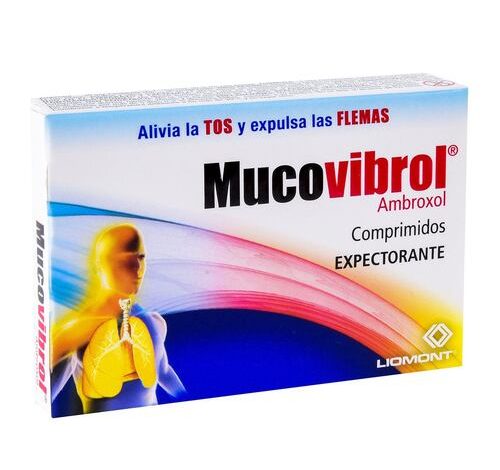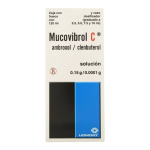Mucovibrol: Uses, Benefits, Dosage, Side Effects, Warnings

Mucovibrol is a brand of Ambroxol a medication widely utilized to alleviate respiratory conditions characterized by the presence of thick or excessive phlegm (sputum). Its primary mechanism of action involves thinning and breaking up mucus, thereby facilitating its removal and relieving congestion. Additionally, Mucovibrol possesses local anesthetic properties, making it effective in providing relief from sore throats.
When administered, Mucovibrol typically begins to take effect within approximately 30 minutes. Its main action involves the breakdown of acid mucopolysaccharide fibers, which in turn reduces the viscosity of sputum, making it less sticky and easier to expel through coughing. This effect persists as long as the treatment regimen is maintained.
Mucovibrol is available in various forms and packaging to accommodate different patient needs and preferences. Here are the common forms and packaging options for Mucovibrol:
1. Tablets:
• Mucovibrol tablets are typically supplied in boxes.
• Each box contains either 10 tablets or 1000 tablets, depending on the quantity needed for treatment.
• Tablets are a convenient option for adults who prefer oral medication in solid form.
2. Syrup:
• Mucovibrol syrup is available in liquid form and is especially suitable for children or adults who have difficulty swallowing tablets.
• The syrup is usually packaged in bottles for ease of administration.
• Two common bottle sizes for Mucovibrol syrup are 60 ml and 120 ml.
• The choice of bottle size may depend on the duration of treatment and the prescribing physician’s recommendations.
Patients and healthcare providers can select the most appropriate form and packaging of Mucovibrol based on the patient’s age, dosage requirements, and personal preferences. It’s essential to follow the prescribed dosage and administration instructions provided by a healthcare professional to ensure safe and effective treatment for respiratory conditions.
Indications
Mucovibrol is prescribed for various medical indications, including:
1. Tracheobronchitis: Inflammation of the trachea and bronchi.
2. Emphysema with bronchitis: A lung condition characterized by damaged air sacs and chronic inflammation of the bronchial tubes.
3. Pneumoconiosis: A group of lung diseases caused by inhaling certain types of dust or particles.
4. Chronic inflammatory pulmonary conditions: Chronic lung diseases associated with persistent inflammation, such as chronic obstructive pulmonary disease (COPD).
5. Bronchiectasis: A condition characterized by the widening and scarring of the airways, leading to mucus buildup.
6. Bronchitis with bronchospasm: Inflammation of the bronchial tubes with accompanying muscle constriction.
7. Asthma: A chronic respiratory condition characterized by airway inflammation and constriction.
Dosage of Mucovibrol
The recommended dosage of Mucovibrol varies according to age and the specific condition being treated:
• Adults: A daily dose typically ranges from 30 mg (equivalent to one Mucovibrol tablet) to 120 mg (equivalent to four Mucovibrol tablets), divided into 2 to 3 doses throughout the day.
• Children up to 2 years: Half a teaspoonful of Mucovibrol syrup is administered twice daily.
• Children aged 2 to 5 years: Half a teaspoonful of Mucovibrol syrup is given three times daily.
• Children over 5 years: One teaspoonful of Mucovibrol syrup is administered 2 to 3 times daily.
It’s important to note that the precise dosage and frequency may vary based on individual patient characteristics and the recommendations of a healthcare provider. Mucovibrol should always be used as directed by a qualified medical professional to ensure its safe and effective use in treating respiratory conditions associated with thick or excessive phlegm.
Mucovibrol side effects
Mucovibrol is generally considered safe when used as directed, but like any medication, it can potentially cause side effects and interact with other drugs. Here are some common side effects and possible drug interactions associated with Mucovibrol:
Common Side Effects
1. Gastrointestinal Disturbances: This can include nausea, vomiting, diarrhea, or stomach discomfort. These symptoms are typically mild and transient.
2. Allergic Reactions: In rare cases, individuals may experience allergic reactions, which can manifest as skin rash, itching, swelling of the face or throat, or difficulty breathing. Seek immediate medical attention if any of these symptoms occur.
3. Central Nervous System (CNS) Effects: Although uncommon, some individuals may experience headaches, dizziness, or a feeling of restlessness.
4. Mouth and Throat Irritation: Mucovibrol syrup may cause local irritation in the mouth and throat, which could lead to a sore throat or a mild burning sensation.
Serious Side Effects (Rare)
Serious side effects with Mucovibrol are rare, but they can occur. These may include severe allergic reactions, such as anaphylaxis, which is a medical emergency. If you experience symptoms such as difficulty breathing, swelling of the face or throat, or a rapid heartbeat, seek immediate medical attention.
Drug Interactions
Mucovibrol may interact with certain medications, potentially affecting their effectiveness or increasing the risk of side effects. Some drug interactions to be aware of include:
1. Cough Suppressants: Combining Mucovibrol with cough suppressants like dextromethorphan can be counterproductive because Mucovibrol works to promote the removal of mucus while cough suppressants aim to reduce coughing. These medications may have conflicting actions.
2. Mucolytics: Mucovibrol is itself a mucolytic, and combining it with other mucolytics may result in an excessive thinning of mucus, potentially leading to airway irritation.
3. Antibiotics: Mucovibrol is sometimes used alongside antibiotics to treat respiratory infections. It can enhance the antibiotic’s penetration into lung tissues, potentially improving their effectiveness.
4. Other Medications: Always inform your healthcare provider about all the medications, supplements, and herbal remedies you are taking to assess potential interactions.
It’s crucial to use Ambroxol under the guidance of a healthcare professional who can consider your medical history and any other medications you are taking.





